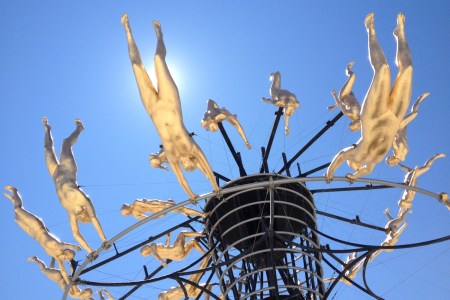After muddy roads trapped roughly 72,000 Burning Man attendees in Black Rock City for days with limited food and water, exodus operations finally began earlier this week, with festivalgoers swapping their desert hellscape for a 12-hour bottleneck on the single two-lane road leading to the nearest highway. Naturally, the whole fiasco has earned comparisons to Fyre Festival, and while it’s easy to laugh at a bunch of wealthy people who paid outrageous amounts of money to attend being stranded in inhospitable conditions, one has to ask: why does this sort of thing keep happening?
Burning Man and Fyre Festival are just the most high-profile examples, but it’s worth remembering that we’re just shy of two years removed from the Astroworld disaster — where 10 people died in a massive crowd crush — and back in 2015, rainy and muddy conditions left thousands of TommorowWorld attendees stranded on the grounds of the Georgia-based EDM fest without shelter. (The latter was such a PR nightmare that TomorrowWorld promotors filed for bankruptcy in 2016 and the festival was discontinued.) The combination of poor planning and inclement weather is hardly a new phenomenon, but why, then, is it still such a persistent issue? Shouldn’t Burning Man organizers have seen this coming?
Heavy Rains Immobilize Burning Man Attendees
Festival-goers were asked to shelter in place“We have come here knowing this is a place where we bring everything we need to survive,” the Burning Man Organization said in a statement issued on Saturday night. “It is because of this that we are all well-prepared for a weather event like this. We have done tabletop drills for events like this. We are engaged full-time on all aspects of safety and looking ahead to our Exodus as our next priority.”
Of course, this usually comes down to greed (though we recognize Burning Man Organization is a non-profit). No one wants to pull the plug on an event they spent thousands or millions of dollars to produce, especially after the COVID-19 pandemic brought the live music industry to a grinding halt. But when you press on in the face of disastrous weather — especially at an event that takes place in the middle of a remote desert with no other resources nearby — you’re risking the health and safety of those in attendance.
People at Burning Man likely brought everything they’d need to survive for the duration of the festival, but being forced to shelter in place for an extra, unanticipated few days means those who didn’t overpack quickly ran out of food and supplies. If 70,000 people stuck in the mud with limited water and sustenance is what a “well-prepared” response looks like, what sort of disaster would have unfolded had they been unprepared?
It’s all par for the course in an industry where promoters place profits over the well-being of concertgoers and festival attendees. They skimp on security and crowd-management costs, and a tragedy like Astroworld unfolds. They prevent fans from bringing in their own water bottles at sweltering summer events, opting instead to charge for them on festival grounds, and then someone inevitably passes out — or worse, dies — from dehydration. And when storms are in the forecast, they take their chances and ride it out instead of preemptively canceling or rescheduling. But how many more events like this do we have to watch unravel into some sort of Lord of the Flies scenario before someone finally says enough is enough and starts holding them accountable?
Thanks for reading InsideHook. Sign up for our daily newsletter and be in the know.













![[L-R] Bill Berry, Michael Stipe, Mike Mills and Peter Buck of R.E.M. at the Aragon Ballroom in Chicago, Illinois on July 7, 1984.](https://www.insidehook.com/wp-content/uploads/2024/12/rem-book-interview.jpg?resize=750%2C750)




